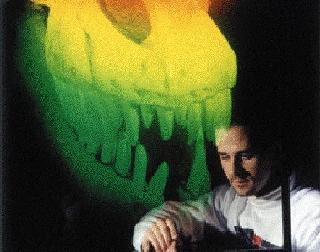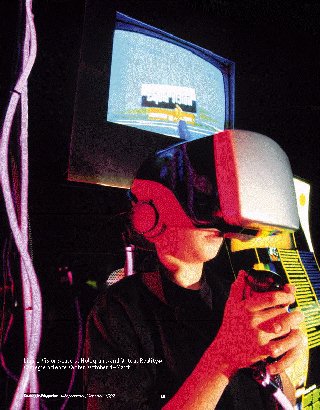
 Come into direct contact with the technology that
is changing our lives in Carnegie Science Center's new exhibit Liquid Vision:
Lasers, Holograms and Virtual Reality. Containing nearly 40 separate exhibit
components divided into six technical realms, Liquid Vision is a hands-on,
body-on journey through the fascinating world of modern technology.
Come into direct contact with the technology that
is changing our lives in Carnegie Science Center's new exhibit Liquid Vision:
Lasers, Holograms and Virtual Reality. Containing nearly 40 separate exhibit
components divided into six technical realms, Liquid Vision is a hands-on,
body-on journey through the fascinating world of modern technology.
Liquid Vision was produced by COSI Columbus in collaboration with The Museum of Science and Industry in Chicago and industry professionals worldwide.
There are several kinds of lasers, and their materials and sizes vary greatly. However, they all have the same three components: a medium (solid, liquid or gas that will emit photons of light), an energy source or pump that will stimulate the medium to emit light, and a means for controlling the direction of the beamùusually with two facing parallel mirrors.
Today lasers are used throughout industry in the fields of science, medicine, communication, defense, printing, photography, recording, energy, manufacturing and entertainment.
A fiber optic cable is composed of many very thin strands of coated glass fibers. It can transmit messages or images by directing beams of light inside itself over distances as long as thousands of miles. The pattern of light waves forms a code that carries a message. At the receiving end, the light beams are converted back into electric current and decoded. Since light beams are immune to electrical noise and can be carried greater distances before fading, fiber optics is used heavily in telecommunications. Other applications include the use of medical fiber optic viewers that allow physicians to see internal organs, fiber optic message devices in aircraft and space vehicles, and fiber optic connections in automotive lighting systems.
Try It Out: In Liquid Vision's laser arcade, participants illuminate
a nighttime skyline with lasers and dazzling fireworks. Then with helium-neon
lasers, they take aim at targets in the cityscape that trigger a brilliant
fireworks display composed of tiny glass fibers.
Holography
A true hologram is a flat, two-dimensional photographic film that when lit at a specific angle, produces the illusion of a three-dimensional object or scene. A hologram is made by splitting a laser beam in two, and each is directed by a mirror to a lens that spreads the beam to the proper size and shape. One beam, called the object beam, illuminates the subject of the hologram. These light waves are reflected onto a photographic plate. The other beam, called a reference beam, is reflected directly onto the plate. The two beams combine on the plate to create an interference pattern, which records the size and shape of the object and the exact direction in which each light wave strikes the plate. After the plate is developed, a laser light is projected through this developed hologram at the same angle as the original reference beam, but from the opposite direction. The pattern scatters the light to create a projected, three-dimensional, ghostlike image of the original object in space.
Holography was originally developed in 1947 to help improve the image quality of electron microscopes. Since they are almost impossible to counterfeit, holograms are used today on credit cards, drivers' licenses and, in Pittsburgh, bus passes. The future hints at uses in movies, television and computer information storage.

Try It Out: Liquid Vision contains nine world-class holograms, some especially commissioned for the exhibit. These white-light holograms, some among the largest in the world, show off the state of the art in still holography. Included are holographic images of a T-rex skull, stars and a tarantula.
Desktop virtual reality systems provide this experience through a computer screen. In other types of virtual reality, the participant wears accessories such as a belt-pack, goggles called head-mounted displays, or data glovesùequipment that acts as direct link-to-brain sensory extensions and provides a feeling of being in the "virtual environment."
With the emergence of computer-based virtual reality over the last 10 years, scientists are beginning to explore the potential of this powerful tool. Today all military and commercial pilots receive some training in virtual reality flight simulators. These mock-cockpits, so sophisticated that they can simulate what it feels like to land on an icy runway, are improving the skills of pilots across the country. Some doctors now use virtual reality systems to practice surgery before performing the real thing.
Try It Out: In Liquid Vision, visitors harness the power of one of today's most powerful imaging computers and venture on a real-time journey through a surreal landscape. High-resolution computer graphics, coupled with a unique 3-D input device, help visitors attain a realistic feeling of control and manipulation.
Morphing is an animation technique where one object, called the source, appears to gradually change, or morph, into a different object, called the target. In each successive frame of the morphing process, the picture elements, or pixels, of the source image are moved and colored to resemble the pixels of the target image. If this is done at different times for different parts of the two images, the objects in the resulting animation appear to blend smoothly together.
Try It Out: Science Center visitors capture a digitized image of their own faces, select a target image, and then start the morphing process. Visitors will observe the computer running through many calculations to smoothly blend their image into that of a green-eyed wolf, King Tut's mask, a VW Bug or even Elvis. When the tape is played back in real time, the transformation is astounding.
Try It Out: In Liquid Vision, visitors take the stage in their own production of a popular music video, playing instruments and singing into the Karaoke microphone. Separate digital audio tracks are activated by standing on various spots on the stage. Surrounding the stage are nine color TV cameras, each producing a different shot of the action. Five are remote controlled by visitors. Two consoles provide live production capabilities, where visitors can mix fly-aways, fades, wipes and rolls with near broadcast quality results. A VCR is linked to the system allowing visitors to make videotapes of their own creations.
Try It Out: All visual art begins with manipulation of the light. Visitors explore the mixing of light by "finger-painting" on a touch-sensitive screen. Activated by body heat, the computer mixes overlaid paint and automatically adjusts screen color, pixel by pixel, to simulate the mixing process. It uses the three primary colors: red, green and blue to produce over 16 million secondary colors.
References
The Handy Science Answer Book, Carnegie Library of Pittsburgh, 1994.
The New Book of Popular Science, Deluxe Library Edition; Grolier
International, Inc., 1994.